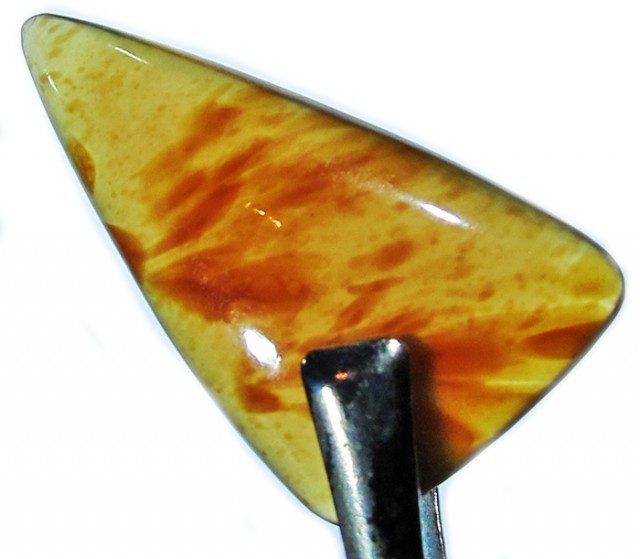
琥珀の宝石:特性、意味、価値など
 琥珀は、樹木の樹脂が化石化した黄橙色の半透明の石で、内部には昆虫や植物が含まれていることが多い。氷河期以前から、地球の歴史を理解するため、また様々なアイテムを作るために、琥珀は人気の素材となってきた。
琥珀は、樹木の樹脂が化石化した黄橙色の半透明の石で、内部には昆虫や植物が含まれていることが多い。氷河期以前から、地球の歴史を理解するため、また様々なアイテムを作るために、琥珀は人気の素材となってきた。
琥珀は宝石とみなされますか?琥珀は鉱物ではないため、宝石ではないと考える人もいます。しかし、多くの人は、装飾用に研磨したりカットしたりできることから、琥珀は宝石だと考えています。
琥珀は希少な宝石ですか?いいえ、琥珀は世界中で採掘可能で、アメリカのカンザス州では州の宝石として指定されています。しかし、バルト海産琥珀(バルト琥珀)は最も希少な宝石です。
琥珀の宝石の歴史、価値、用途などについて詳しく見ていきましょう。
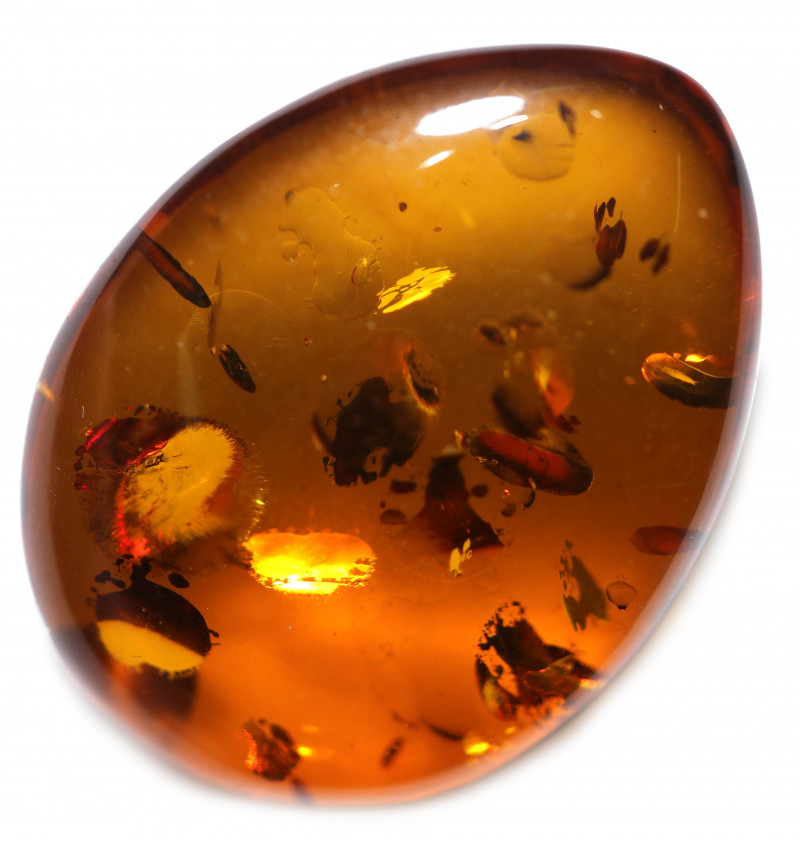
アンバーストーンについて
まず、琥珀は宝石でしょうか?いいえ、琥珀は半貴石であり、数少ない有機宝石の一つです。
古代の名前には、その静電気能力から「エレクトロン」(こすると風船のように物が引き寄せられる)や「デンマークの金」や「神々の涙」などがあります。
宝石以外の用途としては、琥珀の香水やお香などがあります。琥珀の香りはどんな感じでしょうか?煙、革、松の香りが混ざり合った、土っぽくて温かみのある香りです。
琥珀は誰が身につけられる?誰でも!とはいえ、琥珀は獅子座にとって幸運の石です。
琥珀は結婚記念日の宝石ではありませんが、クルピ族の伝統的な結婚式では、花嫁に琥珀の宝石のネックレスを持参金として贈ります。

アンバーの仕様と特徴
琥珀は何でできているのでしょうか?樹脂には炭化水素、コハク酸、油、樹脂が含まれています。
琥珀はどんな木から採れるのでしょうか?主に、 Pinusucciniferaと呼ばれるマツ科の植物や、それに似た針葉樹から採れるもので、樹齢は約4000万年です。
琥珀は、コパル(コパルの木の樹脂が化石化したもの)と混同されることがあります。しかし、コパルは3000万年未満のものです。
本物の琥珀と偽物の琥珀の見分け方は?琥珀の見分け方ガイドをご覧ください!
琥珀のすべての特性は次のとおりです。
モース硬度:2~2.5
色: 黄色、赤、オレンジ、茶色、クリーム色、黒っぽい色。まれに青、緑、紫色
結晶構造:なし(非晶質)
光沢:蝋状または樹脂状
透明性:透明から不透明
屈折率:1.54
密度:1.00~1.10
胸の谷間:なし
骨折:貝殻状
縞模様:白
発光: 時には蛍光を発する。SW-UVでは黄色または灰青色、LW-UVでは淡青色または緑色。稀に、強い蛍光により緑色、青色、または紫色に見える石もある。
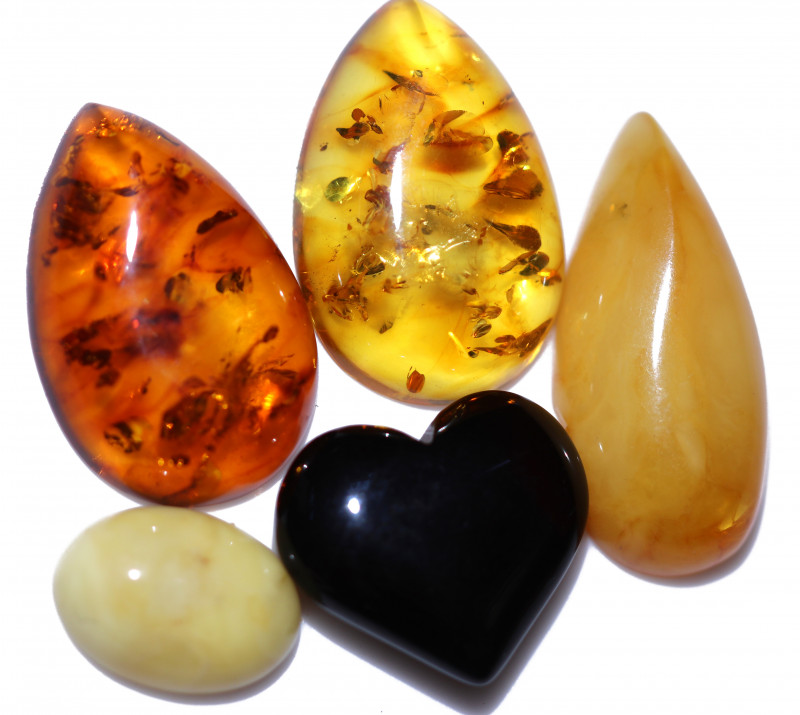
琥珀の種類
アンバーカテゴリーは、国、環境、透明性など多岐にわたります。
最も簡単な分類は色によるもので、以下で詳しく説明します。
イエローアンバー(コモンアンバー)
イエローアンバーは最も一般的な種類で、琥珀全体の約70%を占めています。そのほとんどはバルト海産で、90%はロシアのカリーニングラード産です。イエローアンバーは、よく知られている黄色、オレンジ、または茶色の宝石です。色は単色の場合もあれば、多色の場合もあります。
ブラックアンバー

次に多いのはブラックアンバーで、約15%を占めています。これらの宝石は純粋な黒ではなく、土などの内包物によって濃い茶色や赤の色合いを帯びています。逆光に当てると、茶色、赤、または青の新たな色に変化します。
グリーンアンバー

グリーンアンバーは人気があるものの、わずか2%しか産出されない希少な品種です。色合いは様々で、濃い色ほど価値が高まります。
緑色は植物由来なので、「アースアンバー」と呼ばれることもあります。黄緑色の琥珀は通常天然ですが、深緑色の琥珀の多くは処理されています。
ホワイトアンバー
ホワイトアンバー(「ロイヤルホワイト」または「ボニー」とも呼ばれる)は、わずか1~2%しか存在しない天然の琥珀です。グレー、ブルー、ハニー、グリーンなど、美しい渦巻き模様が自然に見られるため、加工処理は一切施されていません。
レッドアンバー
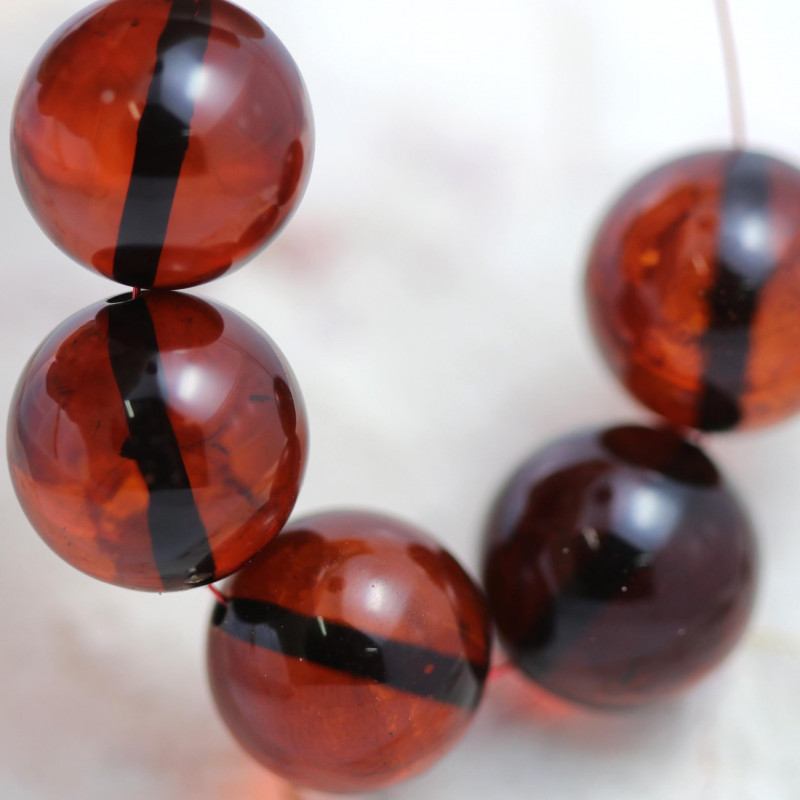
琥珀全体のうち、赤色、いわゆる「チェリーアンバー」と呼ばれるものはわずか0.5%です。チェリーアンバーとは、錆びた赤、金赤色、または濃い茶色の琥珀のことです。この深い赤色は、石に付着した鉄塩の層によるものです。
最後に、最も希少な琥珀は何でしょうか?
ブルーアンバー
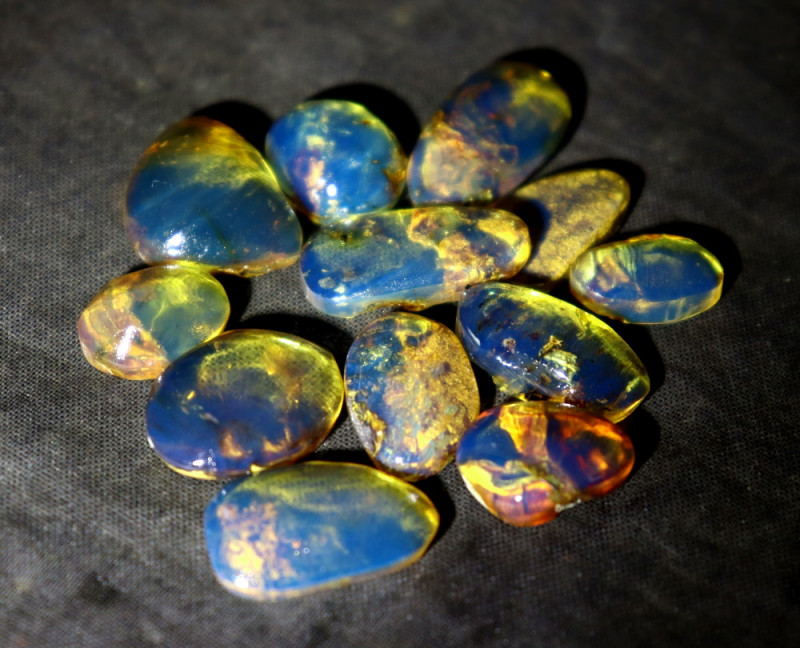
ブルーアンバー、または「ドミニカ産ブルーアンバー」は最も希少で、黄色または茶色に見えますが、太陽光などの紫外線にかざすと鮮やかな青色に変わります。
さて、琥珀の意味は何でしょうか?

琥珀の意味と歴史
アンバーの名前は「香水」を意味するアラビア語の「アンバー」に由来します。
琥珀の宝石の意味と起源については、数多くの伝承があります。ポーランドには、そのような伝説が2つあります。
一つ目は、海岸に打ち上げられた琥珀は海の女神ユラタの海底宮殿の破片であるという説です。ユラタの夫ペルクンは、ユラタと人間の漁師の情事を知り、雷でユラタと宮殿を破壊しました。
二つ目の伝説はクルピシュ族の伝説です。40日間続いた雨が壊滅的な洪水をもたらしました。地元の人々は悲しみに暮れ、泣きました。その涙は水に落ちて琥珀に変化しました。
クルピエの伝説は、琥珀に関する別の古代神話と類似点があり、「太陽の宝石」というニックネームの由来にもなっています。
古代ギリシャ神話では、琥珀はパエトンと結び付けられています。パエトンは太陽神ヘリオスの子でした。パエトンがヘリオスの戦車に激突して命を落とした後、パエトンの姉妹であるヘリアデスはポプラに姿を変え、琥珀の涙を流しました。
歴史
バルト海産琥珀の重要性の一部は歴史的なものです。バルト海産琥珀は、バルト海に面した国々、すなわちスカンジナビア、ポーランド、ロシアから産出されます。
琥珀の使用に関する最古の証拠は、現在のポーランドにあたる新石器時代にまで遡ります。石器時代には、スカンジナビアの人々は「琥珀の道」を経由して、ギリシャやイタリアの製品と琥珀を交易していました。
この宝石に関する最初の記録は、1世紀のローマの博物学者、大プリニウスによるもので、彼はそれをサクシナイトと名付けました。古代ローマ人は琥珀を宝石として用いた宝飾品、食器、香料を製造しました。
ポーランドはおそらく琥珀の歴史において最も豊富な産地であり、そこでは琥珀は「北の黄金」と呼ばれています。
中世には、現在のグダニスクが琥珀細工の中心地となりました。1308年にプロイセン王国が支配し、地元住民が琥珀を所有することさえ禁じられたため、グダニスクの工房は大きな打撃を受けました。
1466年のプロイセン統治の終焉とともに、琥珀の復興が始まり、それは1700年代まで続きました。グダニスクの職人たちは、宗教的および世俗的な琥珀製品を製作しました。中でも最も有名なのは「琥珀の間」です。
この部屋は、プロイセン国王フリードリヒ1世のために10万個近くの琥珀で装飾された書斎として建てられました。ロシア皇帝ピョートル大帝はこの部屋に魅了され、フリードリヒはピョートルに贈りました。ピョートルは職人たちに部屋全体を拡張させました。しかし残念ながら、第二次世界大戦中にナチスによって全てが破壊され、二度と回収されることはありませんでした。
もっと明るい話題として、琥珀は何の役に立つのでしょうか?

琥珀の治癒効果
宝石の色とスピリチュアルなエネルギーが、琥珀をヒーリングストーンにしています。琥珀はヒーリングストーンなのでしょうか?もちろんです!
「アンバー」という色は、文字通りにも精神的にも、オレンジと黄色を組み合わせたものです。アンバーは、黄色の宝石のように太陽神経叢チャクラのチャクラストーンであり、オレンジ色の宝石のような大胆さと活力も備えています。
琥珀は身体的、精神的にどのような効果をもたらすのでしょうか?
身体の治癒
琥珀は疲労回復、特に慢性的な痛みを和らげるエネルギーを与えてくれると言われています。免疫系、神経系、消化器系を強化すると言われています。クリスタルヒーラーは、脳の両半球を調和させるために琥珀を使用しています。
感情的な癒し
感情に働きかける琥珀の宝石の効果には、不安やストレスの緩和などがあります。クリスタルヒーラーは、失恋を経験した人に癒し、前向きな気持ち、そして回復をもたらすと琥珀を勧めています。また、人に媚びへつらう行動を減らし、自己ケアと境界線を守る行動に置き換えるためにも琥珀を勧めています。
琥珀には癒しの効果以外に何か価値があるのでしょうか?もちろんです!
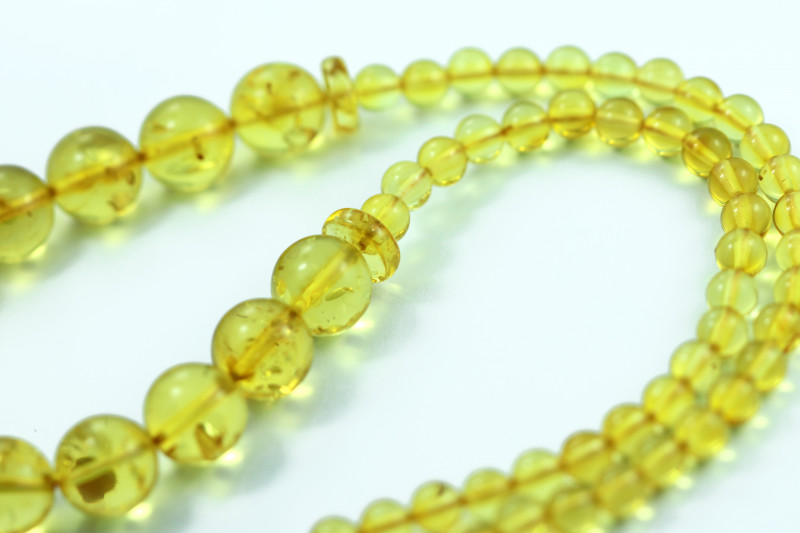
琥珀の宝石の特性
宝石の専門家は、琥珀を他のほとんどの石とは少し異なる方法で等級付けしますが、色、カット、透明度、処理など、同様のカテゴリーに分類します。

色
樹脂は最初は黄色ですが、内包物によって琥珀の色が変化することがあります。琥珀のおよそ3分の2は黄色、茶色、またはオレンジ色です。ほぼすべての琥珀には茶色の斑点があります。
最も価値の高い一般的な色はレッドアンバーで、次にゴールデンイエロー、そしてイエローが続きます。どの色でも、より濃い色合いのものほど価値が高くなります。グリーンアンバーとブルーアンバーは通常、最も高価です。
ブルーアンバーにはさまざまな色合いがあり、そのすべてが価値の高いものから低いものまで等級分けされています。
AAA :濃いコバルトブルー
AA : 飽和したミディアムブルー
A :ミディアムブルー
B :スカイブルー
C : ティール
カット
ほとんどの琥珀は研磨された自由形状の破片となり、しばしば琥珀ビーズに加工されます。ビーズ、 カボション、タンブルストーンはジュエリーとして人気があります。琥珀がファセットカットされることは稀で、不透明な標本は通常、装飾彫刻になります。

明瞭さ
琥珀の価値は内包物によって上下します。内包物のない、完全に透明な琥珀は希少であり、濁った琥珀よりも価値があります。琥珀のクラリティグレードは、内包物の度合いによって決まります。
AAA : インクルージョンフリー
AAB : 不透明で、全体が均一な色
AA :15%以下の含有物
A : 15%以下の内包物、植物や煙の点が見られる
B : 16~35パーセントの含有率
C : 36~60パーセントの含有率
D : 61~99パーセントの含有率
E : 内包物が石全体を覆っている
一般的な内包物としては、植物、昆虫、花粉などが挙げられます。古代の生物や絶滅した植物といった、他に類を見ない内包物は、価値を大幅に高めます。
放射状の星型スパンコールの包含パターンは内部の亀裂から生じますが、通常は処理によって生じます。
カラット重量とサイズ
琥珀はグラム単位またはカラット単位で販売されます。ほとんどの標本は0.5ポンド(約0.23kg)未満ですが、現在知られている最大の標本は、古代のトカゲが入ったバルト海産の33ポンド(15kg)の標本です。
琥珀は軽いため、サイズが大きくなるほどカラット数も少なくなります。3カラットの琥珀は、3カラットのルビーの約4倍の大きさです。琥珀の軽量性は、大ぶりで精巧なステートメントジュエリーを身に着けても違和感がないという利点もあります。
トリートメントと合成
染色と熱処理は比較的一般的です。濁った琥珀はキャノーラ油で加熱すると気泡が消え、透明度が高まります。また、熱処理によって色が濃くなり、星条旗のようなインクルージョンが現れることもあります。
琥珀を染色、あるいは染色と加熱処理を施すことで、緑や赤の色合いを作り出すことができます。また、加熱処理によって琥珀の耐久性も向上します。
1879 年に初めて合成された琥珀はアンバーロイドで、琥珀の破片を結合させたもので、現在でも製造されています。
本物の琥珀は時間の経過とともに色が濃くなりますが、アンバーロイドは通常白くなります。ガラス、プラスチック、または半透明の宝石が模造品としてよく使用されます。

琥珀の形成と起源
地質学者は琥珀がいつ、どのように形成されたかを正確に推定することしかできません。 2021年に発表された、草を含んだ最初の琥珀に関する研究のように、研究は今も新たな知見をもたらし続けています。
琥珀は古代スカンジナビアの森で育ったという点では、ほとんどの科学者が同意しています。議論の的となっているのは、年代と環境です。
多くの地質学者は、琥珀の大部分が 5,600 万年前に形成されたことに同意していますが、推定値は 2,300 万年から 5,600 万年までの範囲です。
始新世の地球は非常に温暖だったため、スカンジナビアの森は針葉樹で覆われていました。これらの木々は、鳥や厳しい天候による傷を覆うための樹脂を生産しました。その樹脂は落下して化石化し、多くの標本が最終的にバルト海沿岸にたどり着きました。

採掘場所
琥珀はどこで採掘されるのでしょうか?現在、約70~90%がポーランドとロシアから産出されています。その他の主要産地はドミニカ共和国とミャンマーです。
それぞれの琥珀鉱床は、さまざまな種類があることで知られています。
バルト海産(コハク石) :最高品質。濃いオレンジ黄色から白まで
ミャンマー(バーマイト) :茶色がかった黄色から濃い茶色。時には透明、淡黄色、淡オレンジ色
ドミニカ共和国: 緑、青、最も透明
メキシコ:黄金色、一部青
ルーマニア(ロマニテ) : 茶色がかった黄色から茶色、茶色がかった赤色、黒
シチリア島、イタリア(シメタイト) :濃い赤からオレンジ色。時には黄色や茶色。乳白色または強い蛍光を発することもある。
地域別に最も高価なものから安価なものにかけては、スカンジナビア、ウクライナ、ロシア、ドミニカ共和国、メキシコとなっています。

アンバーの価格と価値
最も高価な琥珀は何ですか?一般的に、レッドアンバー、グリーンアンバー、そしてユニークな内包物を持つ琥珀が最も高値で取引されます。
琥珀の宝石全体の価格帯は2万ドルから4万ドルです。独特な内包物がある場合、透明なものなら1カラットあたり15ドルから40ドル、大きなものなら1カラットあたり100ドル以上になることもあります。
次に価値の高い琥珀はバルト海産琥珀またはロシア産琥珀で、1カラットあたり2~15ドルです。
ブラックアンバーは通常 1 カラットあたり 1 ~ 4 ドル、レッドアンバーは 1 カラットあたり 3 ~ 6 ドル、ホワイトアンバーは 1 カラットあたり約 10 ドルです。
処理された琥珀は依然として価値が高く、中には1カラットあたり200ドルの値がつくジュエリーもあります。未加工の琥珀の卸売価格は1カラットあたり0.25ドルから2ドル、 青色の未加工の琥珀は1カラットあたり0.20ドルから1ドルです。
アンバーのケアとメンテナンス
琥珀の宝石は適切なお手入れが不可欠です。琥珀の宝石リングには、保護セッティングをお勧めします。
琥珀の基本的なお手入れは、柔らかい布で拭いてください。より強力なクリーニングには、ぬるま湯と中性洗剤に浸した布で拭いてください。
琥珀を以下のものにさらさないでください。
暑さや極寒
アルコール、酸、溶剤
ガソリン
香水、ローション、ヘアスプレー
長時間の浸漬
水上アクティビティ
オリーブオイルで軽く磨くと光沢が戻ります。磨いた後は余分なオイルを拭き取ってください。

アンバーであなたの人生を温めましょう!
人類は驚異的な革新を成し遂げてきましたが、時に母なる地球はそれを凌駕する力を発揮します!古代の琥珀の宝飾品から、刻々と進化する科学的発見まで、地球にはどれほどの魅力的な秘密が隠されているのでしょうか?
今のところは、琥珀のジュエリーや装飾品でその癒しのエネルギーを身近に保ちながら、その自然の美しさをただ楽しむことができます。
バンド「エントランジェント」が歌ったように、「夜に赴き、温かい琥珀から授かった知恵をもって説教するのだ。」
Gemstone Encyclopedia検索
最新記事
ヤシ象牙彫刻は、植物象牙とも呼ばれ、南米のヤシ科植物フィテレファス属のヤシの実から倫理的に採取された、象牙の天然代替品です。このガイドでヤシ象牙についてすべて学びましょう!
15th Jan 2026
レインボーラティスサンストーンは、様々な内包物によって3つのゴージャスな光学的効果を持つ長石の一種です。燃えるように鮮やかな色合いと格子模様が、コレクターにとって希少な宝石となっています。
12th Jan 2026
記事のカテゴリ
How To's is where you will find helpful articles from gem Rock Auctions on how to cut gemstones, select gemstones and buy gemstones.
9記事数

